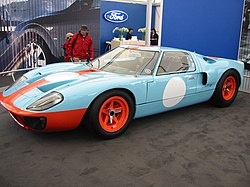Friday, October 14, 2011
The Ford GT 40
In an effort to compete with Ferrari in the Le Mans circuit, Ford created the GT40. It was created following Ferraris winning 6 years in a row up to 1965. The GT40 took its rein in 1966 and won the 24 hours of Le Mans for 4 years strait. It threw Ferrari off of its thrown in its shocking debut. The car was named the GT for grand touring and the 40 representing its overall height of 40 inches as required by the rules. Large displacement Ford V8 engines such as the 4.2 liter, 4.7 liter and 7 liter were used compared to the Ferrari V12 which displaced 3.0 liter or 4.0 liter. During its years of production, it was sold in four different versions. They were called the Mk I, Mk II, Mk III, and Mk IV for short. Although they had subtle differences between them they all dominated the European racing circuit throughout the late 60's.
Out of the engines that were used in the GT 40, none has been more famous than the 5.0 liter. The 5.0 liter engine was not originally 302 cubic inches, but started out much smaller. It started life as the 4.7 liter, 289 cubic inch small block. To turn it into a 302, it had to be bored out to fit larger pistons. Along with the pistons, larger yet thinner rings, different heads were needed to convert it and to produce higher compression. Higher compression ratios gave the engine more horsepower. Soon after, Ford started producing the 302, or 5.0, in regular production vehicles. That basic 302 block was used up until 1995, still keeping a competitive edge with more modern engines.
Subscribe to:
Post Comments (Atom)

1 comment:
I didn't realize this car was built as a direct competitor. It's not often that's done and succeeds.
Post a Comment